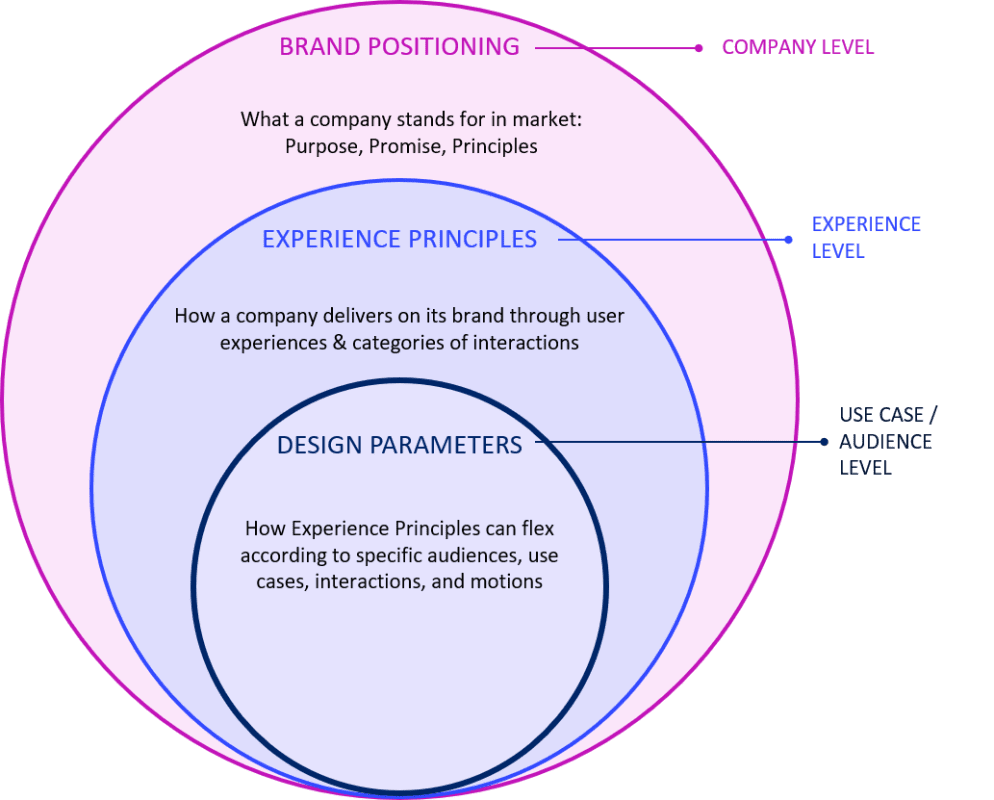BLOG
Branded Customer Experience: Three Steps to Higher Impact
The right positioning, experience principles and design parameters reinforce what is unique about your brand.
Companies have become hyper-focused on delivering frictionless customer experiences, often stripped down to the simplest elements, that brand identity has become an afterthought. With many brands using the same technology platforms and focused on the same goals of “ease” and “speed,” the experiences often begin to fade into a sea of sameness. Too often, the three clicks customers used to book a luxurious escape to a high-end resort, feels exactly the same as that of an overnight at a roadside motel.
Branded experiences remind consumers why they prefer some brands over others and reinforce unique company positioning while encouraging ongoing brand loyalty. Yes, they should be streamlined and seamless. But simple doesn’t have to mean bland. When everyone is offering speed and convenience, companies must find ways to be memorable. That’s because each customer experience, no matter what channel, is a valuable chance to gain relevance. When businesses offer experiences that feel generic, they miss opportunities to deepen connections with customers.
“Simple doesn’t have to mean bland.”
Some companies excel. No one thinks of Costco as just another supermarket – they remember all the times an enthusiastic employee has offered them a tasty free sample or satisfied their cranky toddler with a $1.50 hot dog. And who doesn’t love the way Disney’s magic band allows beloved park characters to know your child’s name without asking?
But when experiences are off-brand, they are destructive. Ask anyone who has recently flown an airline that promised safety but then crams passengers together or has shopped a fitness brand that focuses on self-care but shames larger body sizes.
Critical Connections for High-Impact Experiences
When companies produce unremarkable customer experiences, we typically find the same cause: marketing, product and experience don’t come together early enough. Instead, each group works in their individual silo and by the time they meet to “collaborate,” they’re already entrenched in less-than-ideal solutions. While all three teams are focused on customers, the internal dynamics need to align to provide more clarity on the role each plays.
To be effective, companies need to spell out:
Brand positioning: The brand strategy is the foundation of customer experience. It is what encircles every aspect of how customers meet your brand. Brand positioning delineates a brand’s purpose, promise and principles and should be internalized by employees and resonate with customers.
Experience principles: Overseen by the experience team, these carefully developed standards explain how a company delivers its brand through user experiences and categories of interactions. Experience principles are inspired by brand principles and act as a filter for what differentiates the branded customer experience from its competitors. They guide the team as they develop experience concepts and signature brand moments.
Design parameters: These are the nitty-gritty details that ensure experiences are both helpful to customers and offer genuine moments of brand connection. They guide audience-specific touchpoints, such as products, channels and service. They reflect the brand and experience at the most precise moments, like when a Chick-Fil-A employee says, “My pleasure” instead of “You’re welcome.”
These three components make up the tenets of success. When teams use them to develop projects they are no longer just functional moments —they become branded building blocks that drive emotional responses from consumers. Each parameter clicks into a growing universe of interactions, deliberately reinforcing the brand’s relevance in people’s lives.
3 Tenets of Branded Experience Design

The Three-Step Secret to Powerful Customer Experiences
There are three moves organizations can make to immediately enrich customer experiences.
Come to a High-Level Agreement on the Value of Branded Experiences: Once companies understand that these are a critical component of brand relevance, it’s easier to break down silos. Organizations can avoid tensions and increase productivity when their goal — to create memorable moments of engagement — is aligned from the beginning.
Infuse Brand Strategy in Each Step: It’s important to make the distinction that brand is not more valuable than customer experience. Though brand positioning should be considered at every level of decision-making, encouraging brand police is also not the answer. To do this, the brand team must work harder to distill and communicate a positioning strategy that is most helpful to the experience and product teams. They should also check in with one another early and often, to make sure brand identity isn’t compromised.
Prioritize the Branded Moments That Matter Most: In an ideal world, there would be enough time and money to make every touchpoint perfect. But for most companies, certain moments matter more. Using the experience principles and journey maps will illuminate areas where your brand can best delight customers and differentiate itself from that sea of sameness.
By identifying these areas, teams can focus on what we call signature moments. Signature moments are proof points for customers, embodying the brand’s promise. They aim to elicit specific, positive emotions that relate to the brand’s positioning. Signature moments deepen the relationship with customers, reminding them of what the brand stands for and why they’ve made the right choice. Whether it’s Spotify’s Year in Review, Nike’s self-driven in-store digital exploration or BMW’s driver experiences (including on-ice training in Austria), these connect with customers in ways that are much larger than a single transaction.
FINAL THOUGHTS
Companies need to bring brand, product and experience teams together early on to create branded customer experiences that stand out in a sea of sameness. Not only does early collaboration result in powerful signature moments, but it also paves the way for a smoother experience evolution as market needs and consumer expectations remain ever-changing.
Looking for ways to help your organization create branded customer experiences that lead to growth? Contact our team today.

